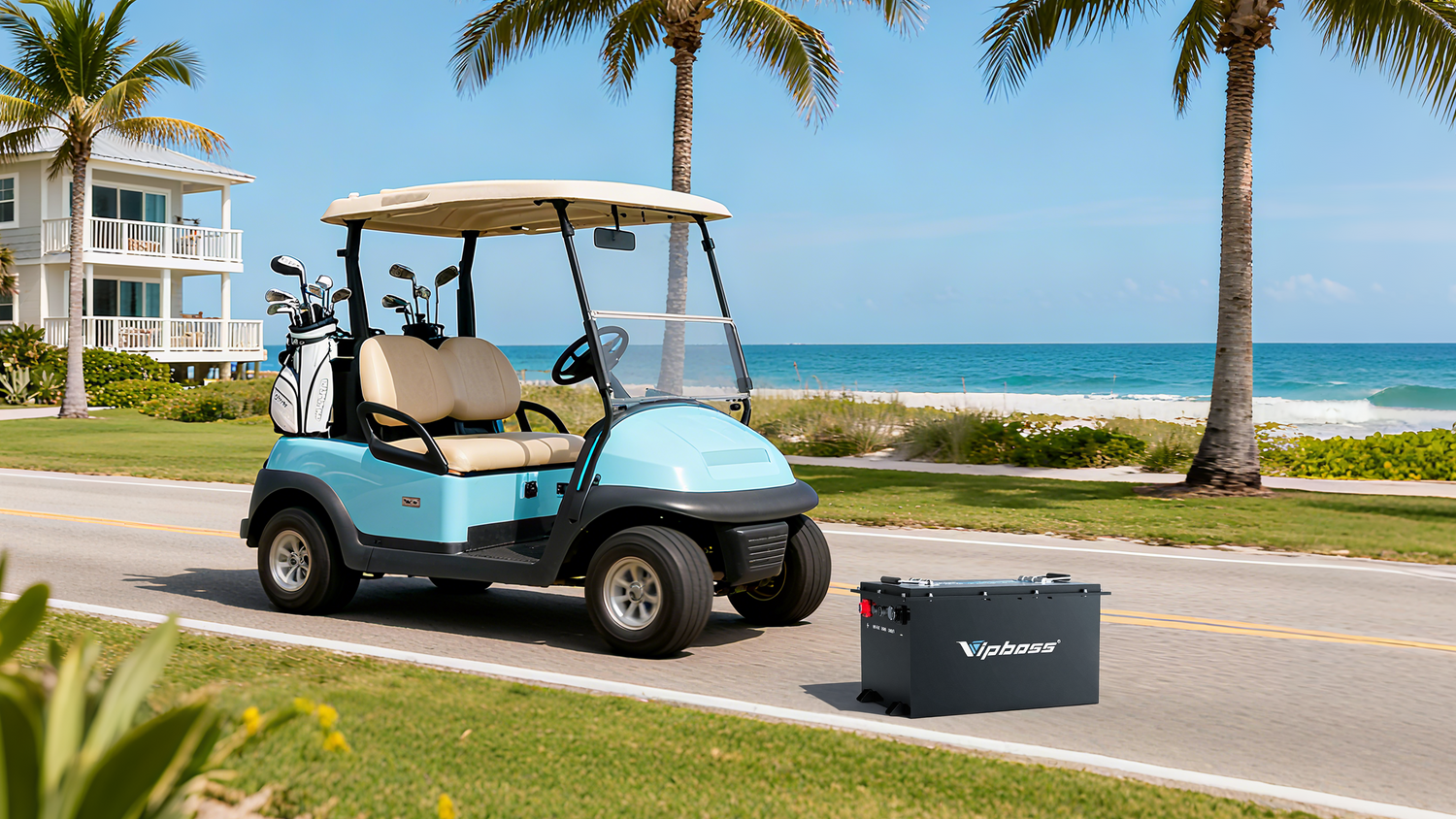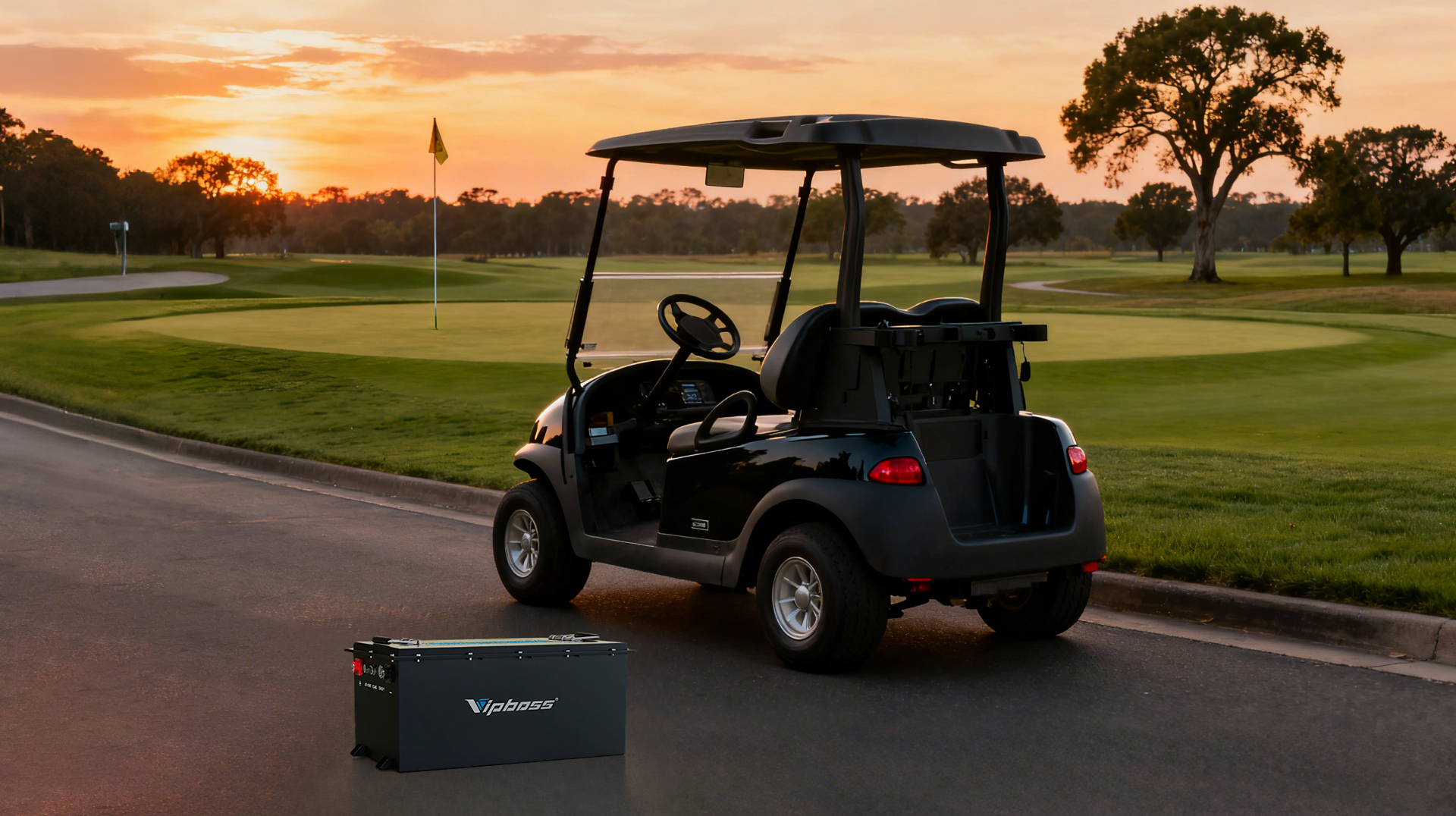You want smooth acceleration, steady power on hills, and fewer maintenance chores. A modern lithium battery can deliver that experience for many golf carts when the choice, setup, and charging are done correctly. This guide explains the essentials in clear steps so you can decide confidently and then convert without surprises.
Lithium Battery Basics
A lithium battery stores energy by moving lithium ions between an anode and a cathode through an electrolyte. In a golf cart application, the common chemistry is lithium iron phosphate, often written as LiFePO4 or LFP. It favors stability and long cycle life, which is what a cart that runs daily or weekly needs. When people say a lithium golf cart battery, they usually mean a pack built from many LiFePO4 cells, managed by a battery management system that keeps the pack safe and balanced.
How Golf Cart Batteries Work
Golf carts draw energy from a battery pack. A controller meters current to the traction motor based on pedal input. Lights, horns, and phone chargers run at 12 volts, supplied by a DC to DC converter when the pack is 36 or 48 volts. The term golf cart batteries may mean the traction pack or the entire energy system, so be precise during planning. The pack sets range and driving feel, and lower internal resistance with a flatter voltage curve help the cart hold speed on hills and near the end of a round.
Comparing Lithium Batteries to Traditional Lead-Acid Batteries
Clear differences show up in weight, usable energy, cycle life, care needs, and lifetime cost. Use the table as a quick map, then the notes below for context.
| Metric | Typical 48V Lead Acid Pack | Typical 48V LiFePO4 Pack |
| Pack weight | About 360 to 420 lb for six or eight flooded batteries | About 90 to 120 lb for a single drop-in or modular pack |
| Usable depth of discharge per cycle | Commonly sized for about 50 percent | Often sized for about 80 to 90 percent |
| Voltage under load | Noticeable sag as charge drops | Flatter curve, stronger feel late in the round |
| Cycle life at stated DoD | Often a few hundred cycles | Often a few thousand cycles |
| Routine care | Watering, corrosion cleaning, venting | Minimal care, visual checks and software checks |
| Storage | Keep charged and ventilated space | Store at partial charge, very low self-discharge |
What Benefits Do Lithium Batteries Provide for Golf Carts?
A lithium setup aims to make the cart feel lively, charge on a predictable schedule, and reduce routine chores. These are the gains owners notice first.
- Consistent power delivery: A flatter voltage curve keeps acceleration steady at a lower state of charge, which helps on hills and with passengers.
- Faster, predictable charging: With a proper constant current and constant voltage LiFePO4 profile, you can recover a useful range in short windows.
- Low maintenance ownership: No watering or acid fumes, and partial-charge storage keeps seasonal use simple.
- Built-in protection: The BMS(Battery management systems) limits current, manages temperature, and balances cells; solid mounting and clean wiring round out safety.

What Potential Drawbacks Do Lithium Batteries Have in Golf Carts?
Good planning removes surprises. Review these items early so the conversion goes smoothly and the system behaves as expected.
- Charger and accessory updates: You need a LiFePO4 charger and a 48-volt to 12-volt DC to DC converter since older carts use lead-acid curves and battery taps.
- Higher upfront cost: Include the charger and DC to DC converter in the budget; lifetime value often balances the purchase price.
- Space and mounting requirements: Confirm tray size and tie-down points, and secure the pack so it cannot move.
- Cold weather charging limits: The BMS may restrict charging at low temperatures, so plan storage and charging in a suitable environment.
How to Convert Your Golf Cart to Lithium Batteries: 4 Steps
Plan the work, record your settings, and match sizing, mounting, and charging to your cart. The four steps below keep the project simple.
Step 1. Assess Your Current Setup
- System check: Confirm pack voltage, controller current rating, motor health, and 12-volt accessory loads.
- Document and measure: Photograph cable routes, measure the battery bay, and note tie-down points.
- Reducer status: Check for a 48-to-12 volt DC-to-DC converter; add one if missing.
Step 2. Choose the Right Lithium Battery
- Size by energy: Watt hours = nominal volts × amp hours; a 48 volt 100 amp hour pack is about 4,800 Wh.
- Plan usable window: Assume about 80–90 percent usable for the daily range.
- Estimate range: Typical carts use about 60–90 Wh per mile, so a two-seat cart lands near 40–70 miles depending on terrain and load.
- Match the BMS: Pick continuous and peak current ratings that meet or exceed your controller demand.
Step 3. Install and Secure the Pack
- Prepare the tray: Remove old batteries, clean the bay, and treat any corrosion.
- Mount solidly: Restrain the pack so it cannot move in any direction.
- Wire correctly: Use equal-length cables of the proper gauge, route away from edges and moving parts, add abrasion sleeves, and torque lugs to spec.
- Power accessories: Feed all 12-volt loads through a DC-to-DC converter, not a single series tap.
Step 4. Adjust Charger Settings
- Use LiFePO4 profile: For 48 volt packs, set full charge near 58.4 volts with a constant-current then constant-voltage finish.
- Set current safely: Choose a charge current your AC circuit and battery can handle without heat issues; enable storage mode for long idle periods if available.
- Verify in a shakedown: Label the cart, take a short drive, check temperatures, and re-torque lugs. After that, routine care is minimal.

Switch to Lithium with a Clear Plan
For most carts, the gains are clear. Weight drops, power stays steady, and charging fits daily routines. The upfront price is higher, yet long life and a larger usable window often repay the difference. To finish strong, size the pack by watt hours, pair a LiFePO4 charger and a 48-volt to 12-volt DC to DC converter, secure the pack, verify settings, and drive.
To finalize the plan, list four specs: system voltage, controller current rating, target range, and storage habits. Those numbers point directly to the right pack size, charger profile, and mounting hardware, so installation is straightforward.
FAQs about lithium golf cart battery
Q1. What charge current should a 48-volt LiFePO4 pack use?
Choose a charger that limits current to what your AC circuit and battery allow, typically 10–25 A for home use. Higher current shortens charge time but raises heat. Verify the pack's recommended charge rate, use the CC then CV profile, and include temperature monitoring during initial shakedown.
Q2. Can a lead-acid charger be reused with a lithium battery?
Only if it supports a LiFePO4 profile or can be programmed for the correct voltage and no float. Legacy ferroresonant chargers are unsuitable. High-frequency models with adjustable setpoints can work when set to about 58.4 V for 48 V packs, with charge termination and no trickle.
Q3. How does cold weather affect a lithium golf cart battery?
Capacity and power drop in the cold, and many BMSs block charging near 0 °C. Store the pack around 40–60% state of charge, keep it dry, and warm it before charging if temperatures are low. Some packs include low-temperature charge protection; still, follow the manufacturer's limits.








Leave a comment
This site is protected by hCaptcha and the hCaptcha Privacy Policy and Terms of Service apply.